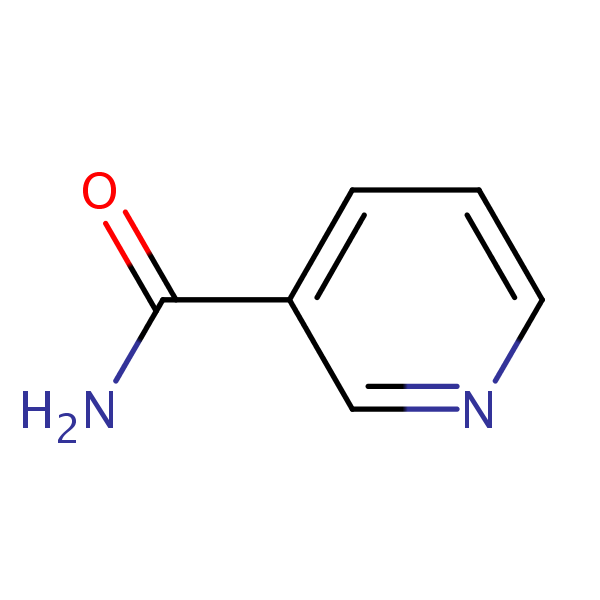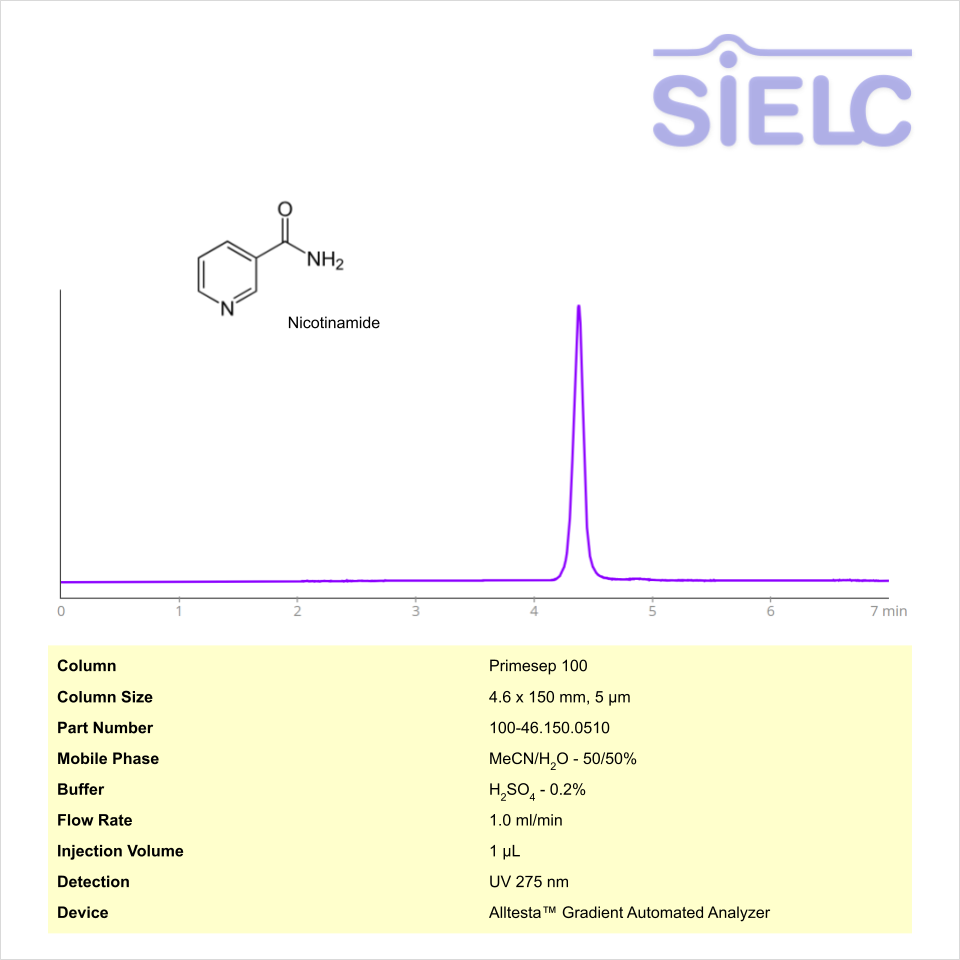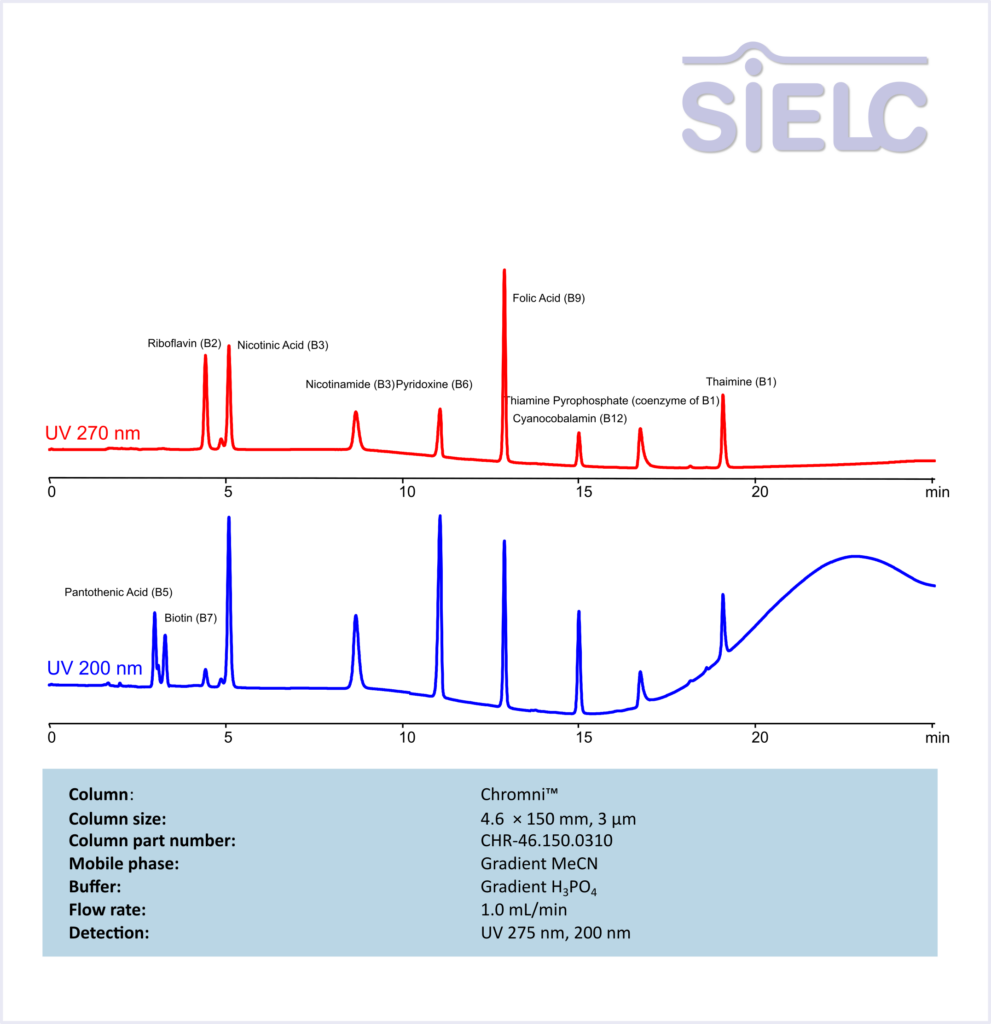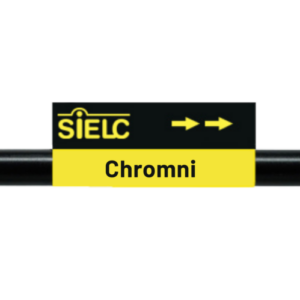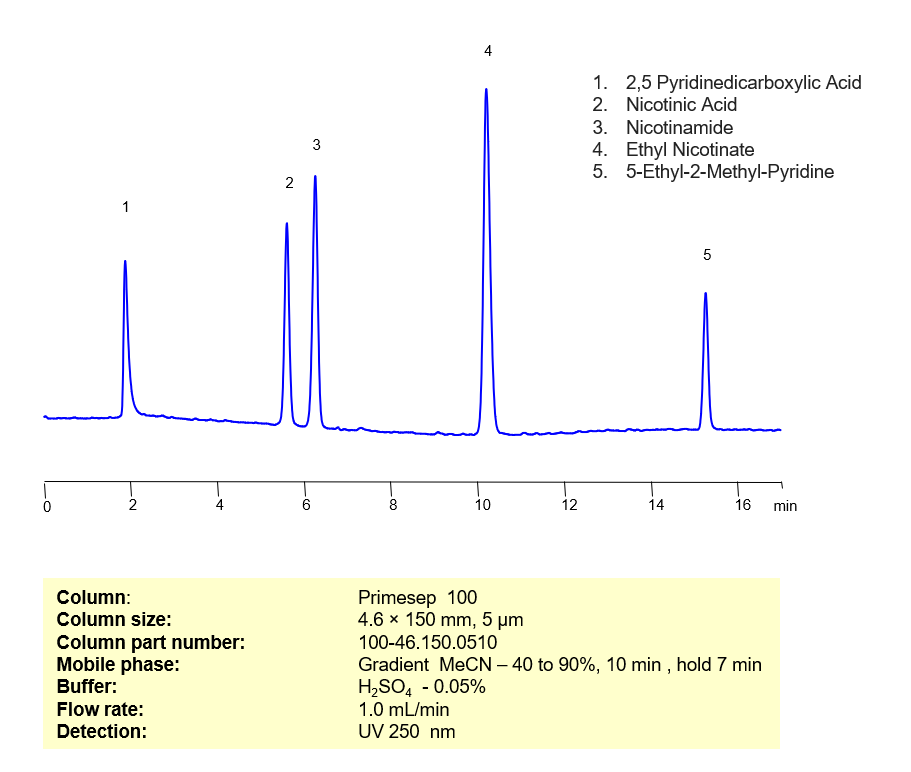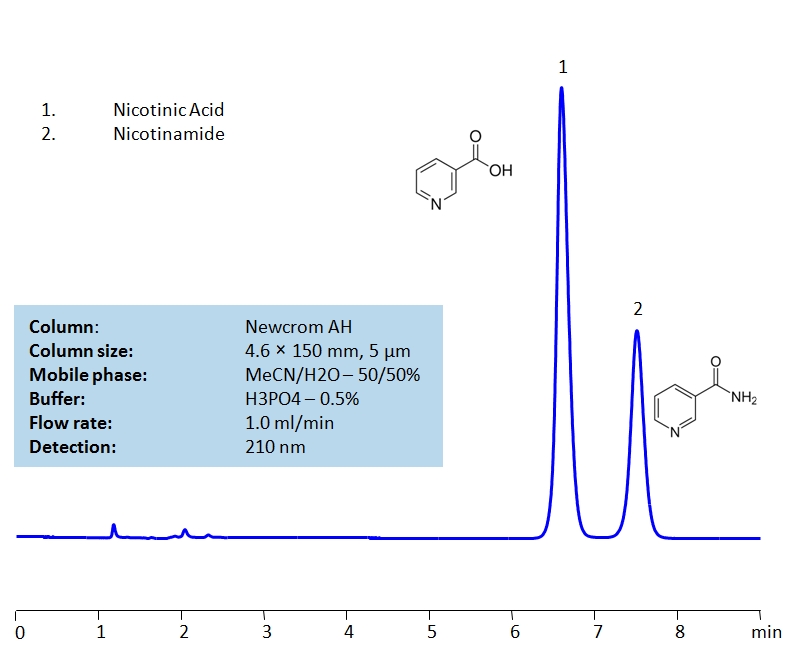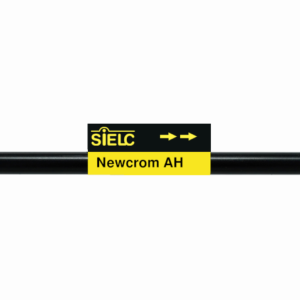| CAS Number | 98-92-0 |
|---|---|
| Molecular Formula | C6H6N2O |
| Molecular Weight | 122.127 |
| InChI Key | DFPAKSUCGFBDDF-UHFFFAOYSA-N |
| LogP | -0.370 |
| Synonyms |
|
Applications:
HPLC Method for Analysis of Nicotinamide on Primesep 100 Column on Alltesta™
November 5, 2025
HPLC Method for Nicotinamide on Primesep 100 by SIELC Technologies
High Performance Liquid Chromatography (HPLC) Method for Analysis of Nicotinamide
Nicotinamide, also known as niacinaminde, is a form of vitamin B3 with the chemical formula C6H6N2O2. It is preferred treatment for pellagra and is a common treatment for acne due to it’s anti-inflammatory properties. If consumed daily, it is shown to decrease the risk of skin cancers other than melanoma.
Nicotinamide can be retained and analyzed using the Primesep 100 stationary phase column. The analysis utilizes an isocratic method with a simple mobile phase consisting of water and acetonitrile (MeCN) with phosphoric acid as a buffer. Detection is performed using UV.
| Column | Primesep 100, 4.6 x 150 mm, 5 µm, 100 A, dual ended |
| Mobile Phase | MeCN – 50% |
| Buffer | Sulfuric Acid |
| Flow Rate | 1.0 mL/min |
| Detection | UV 275 nm |
| Class of Compounds | Vitamin |
| Analyzing Compounds | Nicotinamide |
Application Column
Primesep 100
Column Diameter: 4.6 mm
Column Length: 150 mm
Particle Size: 5 µm
Pore Size: 100 A
Column options: dual ended

HPLC Method for Separation of 10 Water-Soluble Vitamins on Chromni Column
September 17, 2025
HPLC Method for Separation of 10 Water-Soluble Vitamins on Chromni™ by SIELC Technologies
High Performance Liquid Chromatography (HPLC) Method for separation of Vitamin B2 (Riboflavin), Nicotinic Acid/Niacin (3-pyridinecarboxylic acid), Nicotinamide, Vitamin B6 (Pyridoxine), Folic Acid, Cyanocobalamin, Thiamine diphosphate (Thiamine pyrophosphate), Vitamin B1 (Thiamine), Pantothenic Acid, Biotin
Riboflavin (B2), Nicotinic Acid (B3), Nicotinamide (B3), Pyridoxine (B6), Folic Acid (B9), Cyanocobalamin (B12), Thiamine Pyrophosphate (coenzyme of B1), Thiamine (B1), Pantothenic Acid (B5), Biotin (B7) are water soluble vitamins with a key function of energy metabolism. These coenzymes are responsible for converting food into usable energy.
Vitamin B2 (Riboflavin), Nicotinic Acid/Niacin (3-pyridinecarboxylic acid), Nicotinamide, Vitamin B6 (Pyridoxine), Folic Acid, Cyanocobalamin, Thiamine diphosphate (Thiamine pyrophosphate), Vitamin B1 (Thiamine), Pantothenic Acid, Biotin can be retained and analyzed using the Chromni™ stationary phase column. The analysis utilizes a gradient method with a simple mobile phase consisting of water, acetonitrile (MeCN). Detection is performed using UV.
| Column | Chromni™, 4.6 x 150 mm, 3 µm, 100 A, dual ended |
| Mobile Phase | MeCN/H2O – see table |
| Buffer | H3PO4 – see table |
| Flow Rate | 1.0 ml/min |
| Detection | UV 275 nm, 200 nm |
Gradient Elution Program for HPLC Method
| Time (min) | A – H2O (%) | B – MeCN (%) | C – H3PO4 1% in H2O (%) | Notes |
| 0 | 0 | 90 | 10 | Starting Conditions (Hold) |
| 4 | 0 | 90 | 10 | Gradient Start |
| 20 | 20 | 30 | 50 | Gradient End |
| 20.01 | 0 | 90 | 10 | Column Equilibration |
| 30 | 0 | 90 | 10 | End of Run |
| Class of Compounds | Vitamins |
| Analyzing Compounds | Vitamin B2 (Riboflavin), Nicotinic Acid/Niacin (3-pyridinecarboxylic acid), Nicotinamide, Vitamin B6 (Pyridoxine), Folic Acid, Cyanocobalamin, Thiamine diphosphate (Thiamine pyrophosphate), Vitamin B1 (Thiamine), Pantothenic Acid, Biotin |
Application Column
Chromni™
Column Diameter: 4.6 mm
Column Length: 150 mm
Particle Size: 3 µm
Pore Size: 100 A
Column options: dual ended
Cyanocobalamin
Folic Acid
Nicotinamide
Nicotinic Acid/Niacin (3-pyridinecarboxylic acid)
Pantothenic Acid
Thiamine diphosphate (Thiamine pyrophosphate)
Vitamin B1 (Thiamine)
Vitamin B2 (Riboflavin)
Vitamin B6 (Pyridoxine)

HPLC Method for Analysis of Water-Soluble Vitamins (B1, B2, B3, B6) on Primesep 100 Column
August 28, 2024
High Performance Liquid Chromatography (HPLC) Method for Analysis of Water-Soluble Vitamins (B1, B2, B3, B6) on Primesep 100 by SIELC Technologies
Separation type: Liquid Chromatography Mixed-mode SIELC Technologies
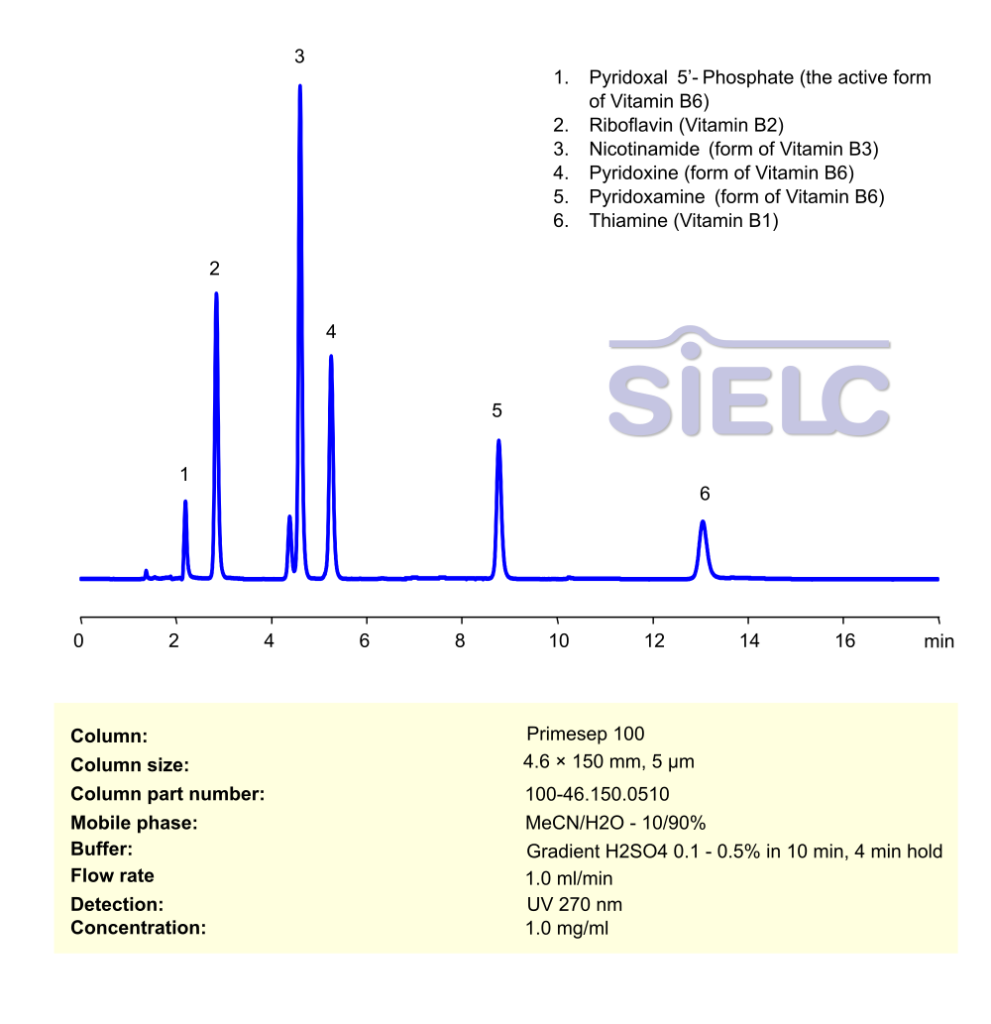
High Performance Liquid Chromatography (HPLC) Method for Analysis of Vitamin B1 (Thiamine), Vitamin B2 (Riboflavin), Nicotinamide, Vitamin B6 (Pyridoxine), Pyridoxamine, Pyridoxal Phosphate
Water-Soluble Vitamins (B1, B2, B3, B6) can be retained, separated and analyzed using a Primesep 100 mixed-mode stationary phase column. The analysis employs an gradient method with a simple mobile phase comprising water, acetonitrile (MeCN), and sulfuric acid as a buffer. This method allows for detection using UV 300 nm.
You can find detailed UV spectra of Vitamin B1 (Thiamine), Vitamin B2 (Riboflavin), Nicotinamide, Vitamin B6 (Pyridoxine), Pyridoxamine, Pyridoxal Phosphate and information about its various lambda maxima by visiting the following links: Vitamins (B1, B2, B3, B6)
| Column | Primesep 100, 4.6 x 150 mm, 5 µm, 100 A, dual ended |
| Mobile Phase | MeCN – 10% |
| Buffer | Gradient H2SO4 -0.1-0.5% in 10 min |
| Flow Rate | 1.0 ml/min |
| Detection | UV 270 nm |
| Class of Compounds | Water-Soluble Vitamins (B1, B2, B3, B6) |
| Analyzing Compounds | Vitamin B1 (Thiamine), Vitamin B2 (Riboflavin), Nicotinamide, Vitamin B6 (Pyridoxine), Pyridoxamine, Pyridoxal Phosphate |
Application Column
Primesep 100
Column Diameter: 4.6 mm
Column Length: 150 mm
Particle Size: 5 µm
Pore Size: 100 A
Column options: dual ended
Pyridoxal Phosphate
Pyridoxamine
Vitamin B1 (Thiamine)
Vitamin B2 (Riboflavin)
Vitamin B6 (Pyridoxine)

UV-Vis Spectrum of Nicotinamide
August 13, 2024
If you are looking for optimized HPLC method to analyze Nicotinamide check our HPLC Applications library
For optimal results in HPLC analysis, it is recommended to measure absorbance at a wavelength that matches the absorption maximum of the compound(s) being analyzed. The UV spectrum shown can assist in selecting an appropriate wavelength for your analysis. Please note that certain mobile phases and buffers may block wavelengths below 230 nm, rendering absorbance measurement at these wavelengths ineffective. If detection below 230 nm is required, it is recommended to use acetonitrile and water as low UV-transparent mobile phases, with phosphoric acid and its salts, sulfuric acid, and TFA as buffers.
For some compounds, the UV-Vis Spectrum is affected by the pH of the mobile phase. The spectra presented here are measured with an acidic mobile phase that has a pH of 3 or lower.

HPLC Method for Analysis of Nicotinamide and Pyridoxine on Primesep 100 Column
August 13, 2024
High Performance Liquid Chromatography (HPLC) Method for Analysis of Nicotinamide, Vitamin B6 (Pyridoxine) on Primesep 100 by SIELC Technologies
Separation type: Liquid Chromatography Mixed-mode SIELC Technologies
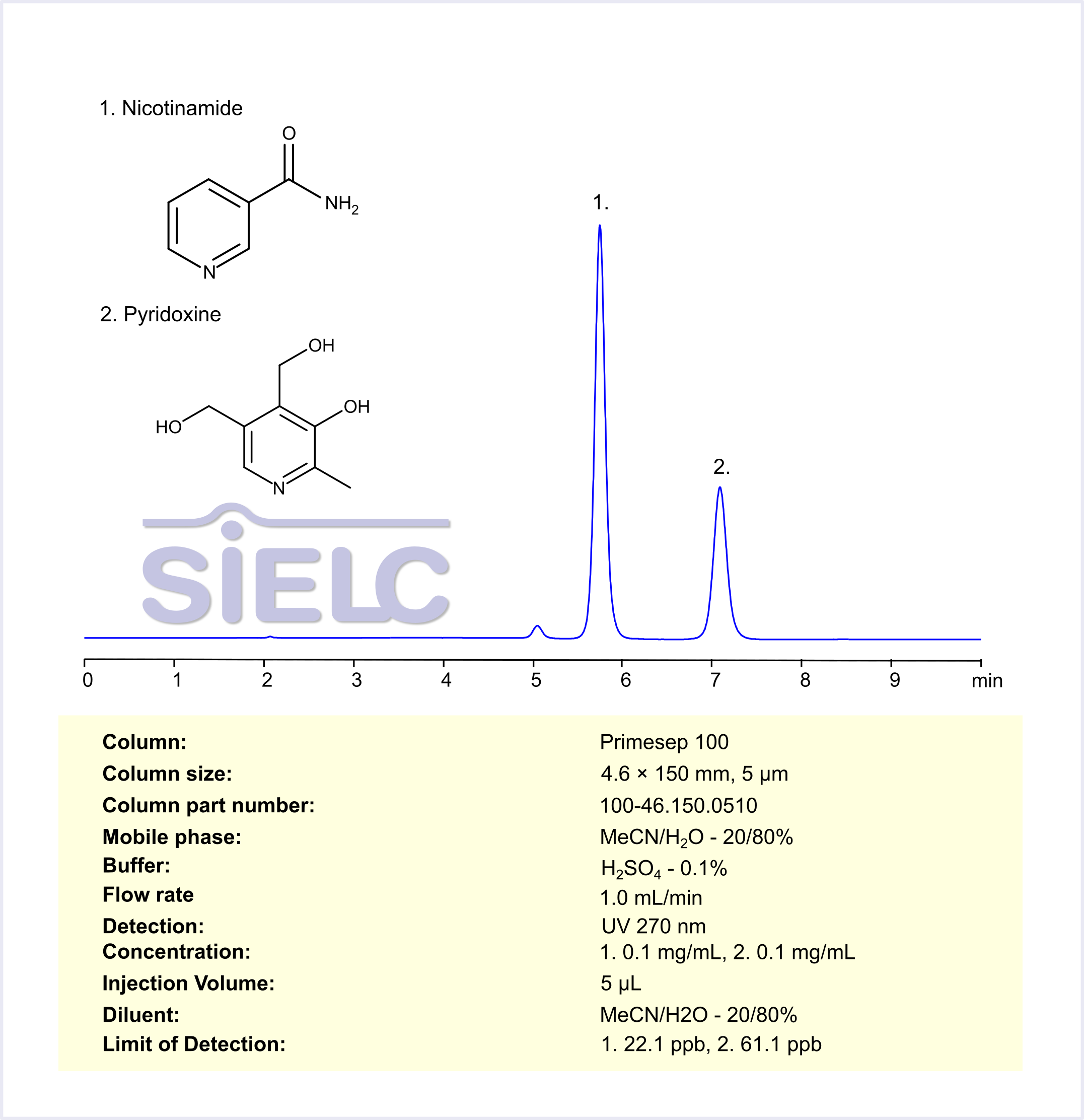
High Performance Liquid Chromatography (HPLC) Method for Analysis of Nicotinamide, Vitamin B6 (Pyridoxine)
Nicotinamide is a specific form of vitamin B3, an essential nutrient that is crucial for various bodily functions. Along with niacin (nicotinic acid), nicotinamide is one of the primary forms of vitamin B3 that the body uses. Both of these forms are converted into coenzymes NAD+ and NADP+, which play vital roles in energy production, DNA repair, and cellular communication. This conversion is essential for maintaining the body’s metabolic processes, highlighting the importance of nicotinamide as a form of vitamin B3.
Pyridoxine is a form of vitamin B6, which is essential for numerous biochemical processes in the body. Vitamin B6 exists in three natural forms—pyridoxine, pyridoxal, and pyridoxamine—all of which are converted into the active coenzyme pyridoxal 5′-phosphate (PLP). This active form is critical for amino acid metabolism, neurotransmitter synthesis, and hemoglobin production. As a form of vitamin B6, pyridoxine is key to maintaining proper neurological and immune function, ensuring that the body can perform a wide range of essential functions.
Nicotinamide, Vitamin B6 (Pyridoxine) can be retained, separated and analyzed using a Primesep 100 mixed-mode stationary phase column. The analysis employs an isocratic method with a simple mobile phase comprising water, acetonitrile (MeCN), and sulfuric acid as a buffer. This method allows for detection using UV 270 nm.
You can find detailed UV spectra of Nicotinamide, Vitamin B6 (Pyridoxine) and information about its various lambda maxima by visiting the following links: UV-Vis Spectrum of Nicotinamide, UV-Vis Spectrum of Pyridoxine.
| Column | Primesep 100, 4.6 x 150 mm, 5 µm, 100 A, dual ended |
| Mobile Phase | MeCN – 20% |
| Buffer | H2SO4 – 0.1% |
| Flow Rate | 1.0 ml/min |
| Detection | UV 270 nm |
| Limit of Detection | 1. 22.1 ppb, 2. 61.1 |
| Class of Compounds | Vitamin B |
| Analyzing Compounds | Nicotinamide, Vitamin B6 (Pyridoxine) |
Application Column
Primesep 100
Column Diameter: 4.6 mm
Column Length: 150 mm
Particle Size: 5 µm
Pore Size: 100 A
Column options: dual ended
Vitamin B6 (Pyridoxine)

HPLC Method for Separation of Nicotinic Acid, Nicotinamide, Tranexamic Acid on Primesep 100 Column
March 28, 2024
HPLC Method for Separation of Nicotinic Acid, Nicotinamide, Tranexamic Acid on Primesep 100 Column
Separation type: Liquid Chromatography Mixed-mode SIELC Technologies
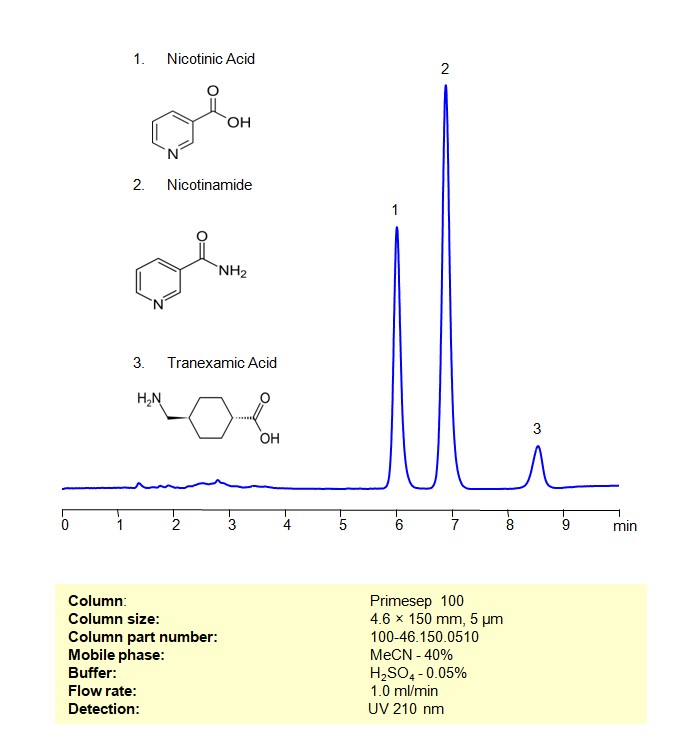
High Performance Liquid Chromatography (HPLC) Method for Analysis of Nicotinic Acid/Niacin (3-pyridinecarboxylic acid), Nicotinamide, Tranexamic acid
Nicotinic acid and nicotinamide are both forms of vitamin B3, also known as niacin. They play crucial roles in the body’s energy metabolism and are essential for maintaining the health of the skin, nervous system, and digestive system.
- Nicotinic Acid (Niacin): This is one of the two principal forms of vitamin B3. Nicotinic acid is commonly used as a dietary supplement to treat vitamin B3 deficiency, and it’s also prescribed in higher doses to help lower cholesterol levels. It works by dilating blood vessels, which can lead to a flushing sensation, hence it is sometimes referred to as “flushing niacin.”
- Nicotinamide: Also known as niacinamide, this is the other principal form of vitamin B3. Nicotinamide is a precursor to nicotinamide adenine dinucleotide (NAD+), a coenzyme involved in various cellular processes, including energy metabolism. Nicotinamide is often used in skincare products for its anti-inflammatory properties and its ability to improve the appearance of aging skin and reduce hyperpigmentation.
Tranexamic acid, on the other hand, is a synthetic derivative of the amino acid lysine. It is primarily used as an antifibrinolytic agent, meaning it helps to prevent the breakdown of blood clots. Tranexamic acid is commonly used to treat or prevent excessive bleeding, particularly in conditions such as heavy menstrual bleeding, traumatic hemorrhage, and during surgeries where significant blood loss is expected. Additionally, it has been investigated for its potential role in treating melasma, a common skin condition characterized by hyperpigmentation.
Each of these compounds has distinct biochemical properties and medical applications, but they all play important roles in human health and medicine.
Nicotinic Acid, Nicotinamide, Tranexamic Acid can be retained and separated using a Primesep 100 mixed-mode stationary phase column. The analysis employs an isocratic method with a simple mobile phase comprising water, acetonitrile (MeCN), and sulfuric acid as a buffer. This method allows for detection using UV at 210 nm
| Column | Primesep 100, 4.6 x 150 mm, 5 µm, 100 A, dual ended |
| Mobile Phase | MeCN 40% |
| Buffer | H2SO4 – 0.05% |
| Flow Rate | 1.0 ml/min |
| Detection | UV 210nm |
| Class of Compounds | Acids |
| Analyzing Compounds | Nicotinic Acid/Niacin (3-pyridinecarboxylic acid), Nicotinamide, Tranexamic acid |
Application Column
Primesep 100
Column Diameter: 4.6 mm
Column Length: 150 mm
Particle Size: 5 µm
Pore Size: 100 A
Column options: dual ended
Nicotinic Acid/Niacin (3-pyridinecarboxylic acid)
Tranexamic acid

HPLC Method for Simultaneous Determination of Nicotinic Acid, Nicotinamide, Pyridine Dicarboxylic Acid, Ethyl Methyl Pyridine and Ethyl Nicotinate on Primesep 100 Column
August 29, 2022
HPLC Method for Nicotinic Acid/Niacin (3-pyridinecarboxylic acid), Nicotinamide, Pyridinedicarboxylic Acid, 2,5-Pyridinedicarboxylic acid, 5-Ethyl-2-methylpyridine, Ethyl nicotinate on Primesep 100 by SIELC Technologies
High Performance Liquid Chromatography (HPLC) Method for Analysis of Nicotinic Acid/Niacin (3-pyridinecarboxylic acid), Nicotinamide, Pyridinedicarboxylic Acid, 2,5-Pyridinedicarboxylic acid, 5-Ethyl-2-methylpyridine, Ethyl nicotinate.
2,5-Pyridinedicarboxylic acid (PDA), also known as Dipicolinic acid (DPA), is a key factor in bacterial endospore heat resistance. It also plays an important role in preparing transition metal complexes for ion chromatography.
Nicotinic acid, also known as niacin, is a water-soluble B vitamin with C6H5NO2 molecular formula. It is an essential nutrient that plants and animals synthesize from tryptophan. It is also used as a dietary supplement to treat pellagra, which is characterized by dermatitis of sunlight-exposed skin and is said to be caused by a corn-based diet. Nicotinic acid was found on asteroids and meteorites.
Nicotinamide, also known as niacinaminde, is a form of vitamin B3 with the chemical formula C6H6N2O2. It is preferred treatment for pellagra and is a common treatment for acne due to it’s anti-inflammatory properties. If consumed daily, it is shown to decrease the risk of skin cancers other than melanoma. It is a derivative of Nicotinic acid and is a key component of the coenzymes nicotinamide adenine dinucleotide (NAD) and nicotinamide adenine dinucleotide phosphate (NADP+). You can find detailed UV spectra of Nicotinamide and information about its various lambda maxima by visiting the following link.
Ethyl nicotinate, also known as nicotine acid ethyl ester, has the chemical formula C8H9NO2. It is a popular topical treatment for ligament, joint, and muscle pain.
5-Ethyl-2-methylpyridine is a common precursor to Nicotinic acid with the chemical formula C8H11N. It is produced by condensation of paraldehyde and ammonia.
Nicotinic Acid/Niacin (3-pyridinecarboxylic acid), Nicotinamide, Pyridinedicarboxylic Acid, 2,5-Pyridinedicarboxylic acid, 5-Ethyl-2-methylpyridine, Ethyl nicotinate can be separated, retained, and analyzed on a Primesep 100 mixed-mode column using an analytical method with a simple gradient mobile phase of water, Acetonitrile (MeCN), and a sulfuric acid (H2SO4) buffer. This analysis method can be UV detected at 250 nm with high resolution and peak symmetry.
| Column | Primesep 100, 4.6 x 150 mm, 5 µm, 100 A, dual ended |
| Mobile Phase | MeCN – Gradient |
| Buffer | H2SO4 – 0.05% |
| Flow Rate | 1.0 ml/min |
| Detection | UV 250 nm |
| Class of Compounds | Drug, Acid |
| Analyzing Compounds | Nicotinic Acid/Niacin (3-pyridinecarboxylic acid), Nicotinamide, Pyridinedicarboxylic Acid, 2,5-Pyridinedicarboxylic acid, 5-Ethyl-2-methylpyridine, Ethyl nicotinate |
Application Column
Primesep 100
Column Diameter: 4.6 mm
Column Length: 150 mm
Particle Size: 5 µm
Pore Size: 100 A
Column options: dual ended
5-Ethyl-2-methylpyridine
Ethyl nicotinate
Nicotinamide
Nicotinic Acid/Niacin (3-pyridinecarboxylic acid)
Pyridinedicarboxylic Acid

Analysis of Nicotinic Acid and Nicotinamide (Vitamin B3) on Newcrom AH Column
July 6, 2015
Nicotinamide is the amide form of nicotinic acid. Nicotinic acid is in the vitamin B group and is converted to nicotinamide in vivo. Newcrom AH was used to separate nicotinamide and nicotinic acid. Newcrom AH separates acids using ion-exclusion, retains basic compounds by cation-exchange, and neutral compounds by reverse-phase mechanism.
| Column | Newcrom AH, 4.6×150 mm, 5 µm, 100A |
| Mobile Phase | MeCN/H2O – 50/50% |
| Buffer | H3PO4 – 0.5% |
| Flow Rate | 1.0 ml/min |
| Detection | UV, 210 nm |
| Class of Compounds |
Acid, Hydrophilic, Ionizable, Vitamin, Supplements |
| Analyzing Compounds | Nicotinic Acid, Nicotinamide, Vitamin B3 |
Application Column
Newcrom AH
The Newcrom columns are a family of reverse-phase-based columns. Newcrom A, AH, B, and BH are all mixed-mode columns with either positive or negative ion-pairing groups attached to either short (25 Å) or long (100 Å) ligand chains. Newcrom R1 is a special reverse-phase column with low silanol activity.
Select optionsNicotinamide
Nicotinic Acid/Niacin (3-pyridinecarboxylic acid)

Separation of Nicotinamide and Related Substances
May 11, 2015
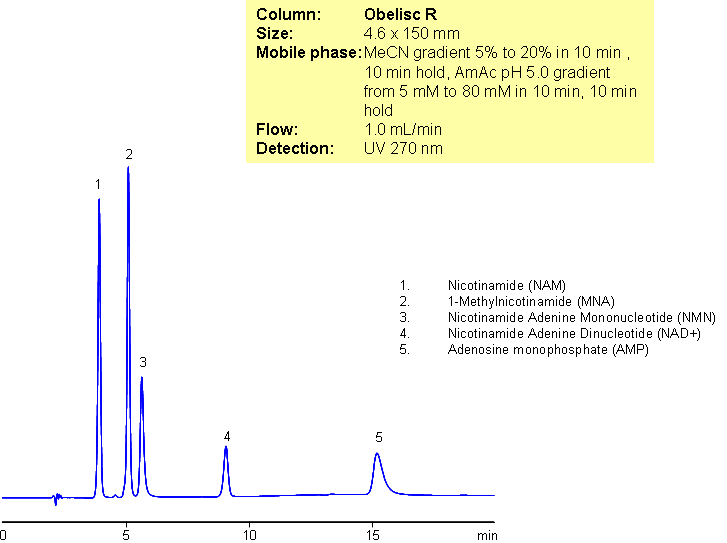
A complex mixture of nicotinamide and related impurities was separated on Obelisc R mixed-mode column. Nicotinamide, methylnicotinamide, nicotinamide adenine mononucleotide, nicotinamide adenine dinucleotide, and adenosine monophosphate were baseline resolved in a 15 minute long method. This mixed-mode approach can be used for analysis of other nucleotides. Obelisc R trimodal column separates this complex mixture based on reversed-phase, cation-exchange and anion-exchange mechanisms. Retention is controlled by amount of ACN, buffer concentration and buffer pH. Additional selectivity can be gained by exploring various buffers within the same pH
Application Column
Obelisc R
SIELC has developed the Obelisc™ columns, which are mixed-mode and utilize Liquid Separation Cell technology (LiSC™). These cost-effective columns are the first of their kind to be commercially available and can replace multiple HPLC columns, including reversed-phase (RP), AQ-type reversed-phase, polar-embedded group RP columns, normal-phase, cation-exchange, anion-exchange, ion-exclusion, and HILIC (Hydrophilic Interaction Liquid Chromatography) columns. By controlling just three orthogonal method parameters - buffer concentration, buffer pH, and organic modifier concentration - users can adjust the column properties with pinpoint precision to separate complex mixtures.
Select optionsAdenosine Monophosphate
Nicotinamide
Nicotinamide Adenine Dinucleotide (NAD)
Nicotinamide Adenine Mononucleotide
UV Detection

